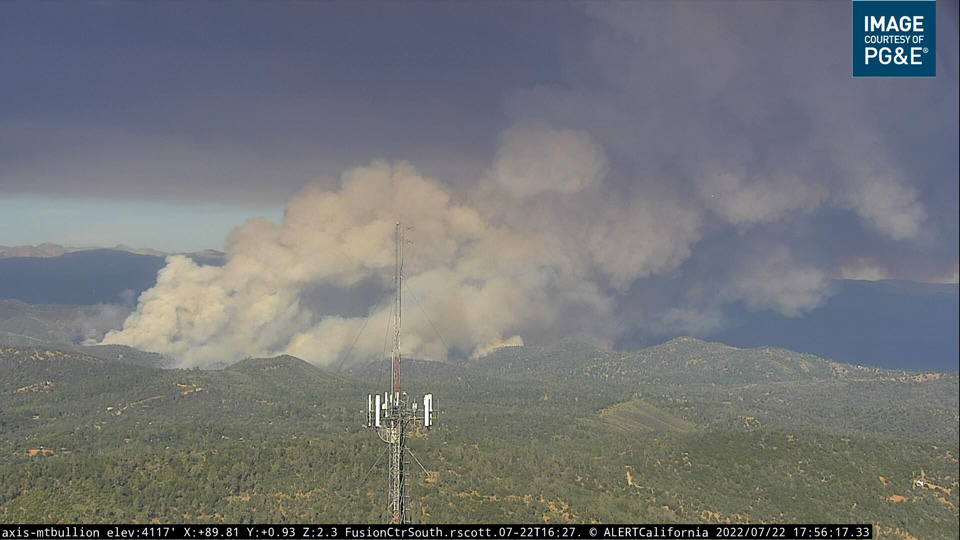
Oak Fire in Mariposa County from the PG&E Mount Bullion Live Camera on Friday, July 22, 2022 at 5:56 P.M.
July 28, 2022 - Washington, D.C. – Today, Thursday, July 28, the House is expected to consider and vote on H.R. 5118, the Wildfire Response and Drought Resiliency Act (WRDR Act), led by National Parks, Forests, and Public Lands Subcommittee Chair Joe Neguse (D-Colo.). The legislative package includes text from 49 bills and will provide much-needed investments to improve fire-adapted ecosystems, protect communities against catastrophic wildfires, enhance drought resiliency, expand science programs, modernize data and technology, and ensure a whole-of-government approach to wildfire and drought issues.
The full text for the WRDR Act is available here.
A section-by-section of the bill is available here.
A summary of the bill is available here.
A one-pager for the bill is available here.
The Biden administration’s statement of support for the bill is available here.
Climate change, a century of fire suppression, and a growing number of people living and recreating within the wildland-urban interface have all contributed to increased wildfire risk nationally. Wildfires are now a year-round threat, burning larger areas with greater intensity. Climate change has also made drought more severe and persistent, with parts of the western United States experiencing their driest conditions in over 1,200 years. As of mid-July, nearly half of the United States are in drought.
Failing to take more strategic and targeted action on wildfire and drought is not just unsafe, but also expensive. Together, the effects of wildfire and drought cost the United States roughly $20 billion in 2021 alone.
To improve wildfire response, the WRDR Act:
- Establishes new hiring authorities and a minimum basic pay rate (approximately $20/hour) for wildland firefighters, as well as mental health leave and hazard pay.
- Authorizes a 10-Year National Wildfire Response Plan for landscape-scale projects across the country.
- Provides tools and resources to assist communities’ wildfire activities, including prescribed fires, and supports opportunities for Tribes and Conservation Corps in wildfire activities.
To improve drought resiliency, the WRDR Act:
- Provides $500 million to prevent key reservoirs of the Colorado River from declining to unsafe levels.
- Invests in innovative drought-proof water infrastructure, including water recycling and desalination projects.
- Secures water reliability for Indian Country, by advancing tribal water rights settlements, investing $1 billion in tribal clean water access, and supporting technical assistance for tribal water needs.
- Supports the development of modern water management data and technology.
- Protects and restores important ecosystems and wildlife populations that have been impacted by drought and climate change.
To ensure a comprehensive, whole-of-government approach to wildfire and drought, the WRDR Act also:
- Improves wildfire-related programs at the Department of Energy, Federal Energy Regulatory Commission Federal Emergency Management Agency, U.S. Environmental Protection Agency and U.S. Fire Administration and provides improved assistance and relief for communities that have been impacted by recent wildfires.
- Establishes the National Disaster Safety Board and directs the President to establish a National Wildland Fire Risk Reduction Program.
- Advances environmental justice for communities that have been disproportionately harmed by environmental discrimination and climate change-induced wildfire and drought.
The House Natural Resources Committee has held several legislative and oversight hearings on bills included in the WRDR Act:
- Full Committee Legislative Hearing on H.R. 2021
- Water, Oceans, and Wildlife Subcommittee Legislative Hearing on H.R. 3877 & H.R. 4099
- Water, Oceans, and Wildlife Subcommittee Oversight Hearing "Building Back Better: Building Resilience for the Economy, Climate, and Ecosystems"
- Water, Oceans, and Wildlife Subcommittee Oversight Hearing "The Status of Drought Conditions Throughout the Western United States"
- Water, Oceans, and Wildlife Subcommittee Oversight Hearing "Colorado River Drought Conditions and Response Measures – Day One"
- Water, Oceans, and Wildlife Subcommittee Oversight Hearing "Colorado River Drought Conditions and Response Measures – Day Two"
- Water, Oceans, and Wildlife Subcommittee Legislative Hearing on H.R. 4832, H.R. 5001 & H.R. 5345
- Water, Oceans, and Wildlife Subcommittee Oversight Hearing "Klamath River Basin Conditions and Opportunities"
- Water, Oceans, and Wildlife Subcommittee Legislative Hearing on H.R. 5880, H.R. 6238, H.R. 7612, H.R. 7632 & H.R. 7633
- Water, Oceans, and Wildlife Subcommittee Legislative Hearing on H.R. 7792 & H.R. 7793
- Water, Oceans, and Wildlife Subcommittee Legislative Hearing on H.R. 8090
- National Parks, Forests, and Public Lands Subcommittee Oversight Hearing "Wildfire in a Warming World: Opportunities to Improve Community Collaboration, Climate Resilience, and Workforce Capacity"
- National Parks, Forests, and Public Lands Subcommittee Legislative Hearing on H.R. 2049
- National Parks, Forests, and Public Lands Subcommittee Oversight Hearing “Examining the Potential for a Civilian Climate Corps”
- National Parks, Forests, and Public Lands Subcommittee Legislative Hearing on H.R. 4274 & H.R. 5631
- National Parks, Forests, and Public Lands Subcommittee Oversight Hearing "Investing in Wildfire Management, Ecosystem Restoration, and Resilient Communities: Examining the Biden Administration’s Priorities for Implementation of the Bipartisan Infrastructure Law"
- National Parks, Forests, and Public Lands Subcommittee Legislative Hearing on H.R. 279
Additional resources on the WRDR Act:
- U.S. Forest Service: Confronting the Wildfire Crisis
- The National Cohesive Wildland Fire Management Strategy
- Dear Colleague: Vote YES on the Wildfire Response and Drought Resiliency Act
- Dear Colleague: Democrats Highlight Bipartisan Achievements to Address Western Drought and Wildfires
Source: Natural Resources Committee Chair Raúl M. Grijalva








